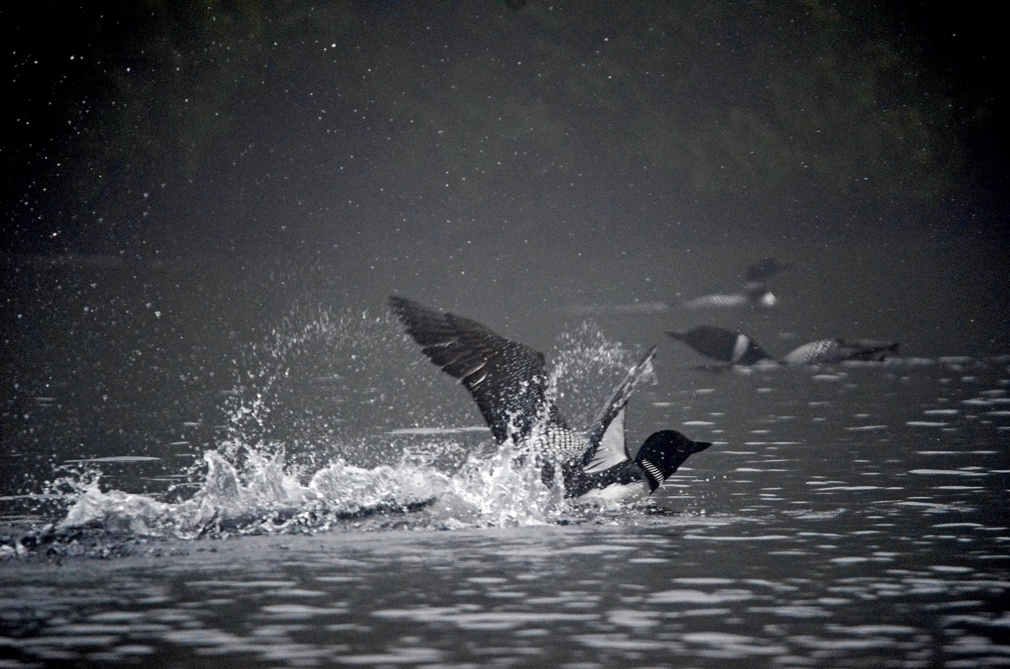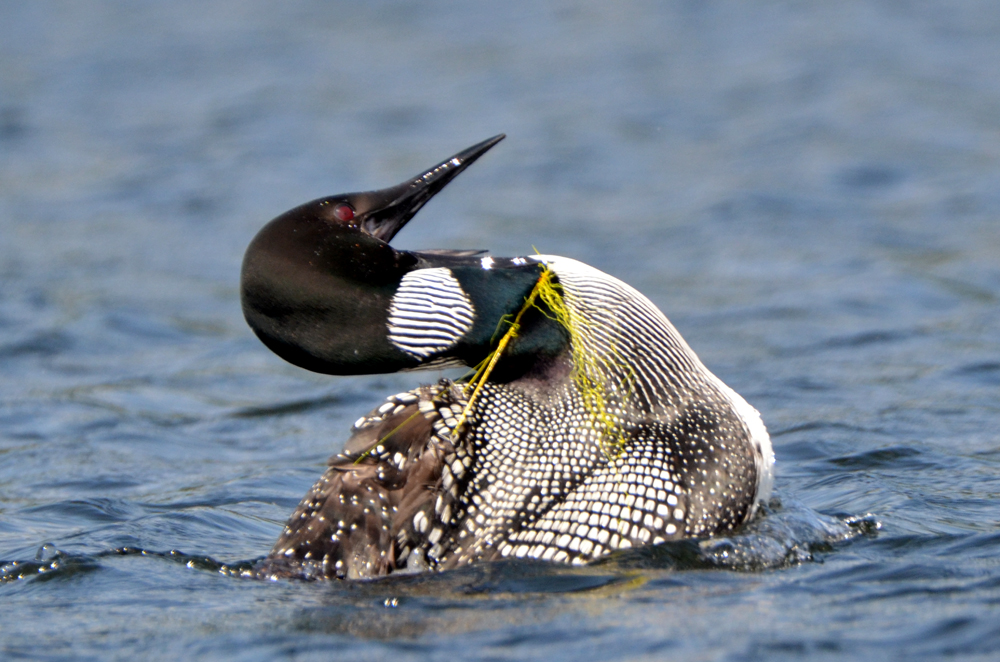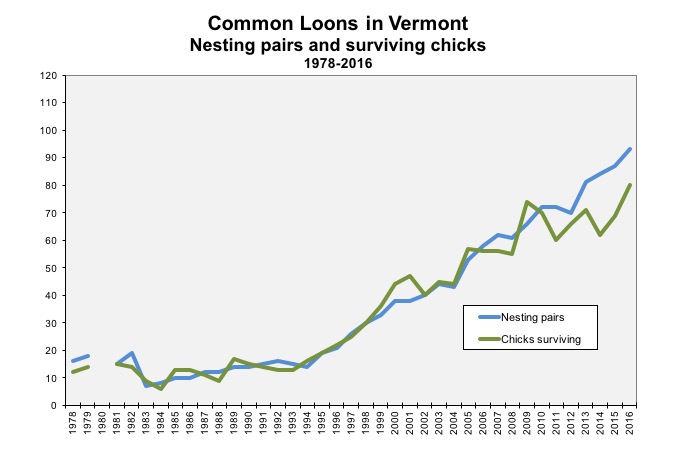
Several intruder loons visit Bald Hill Pond a day after the chicks hatched out in July. Both chicks are doing well as of late August despite regular visits by extraterritorial loons. Photo by Lorna Kane-Rohloff
This year was another very good breeding season for Common Loons in Vermont. We found a record 97 nest attempts with at least 72 of them successful fledging young. Many loon pairs produced two chicks resulting in over 110 successfully fledging. We won’t know final numbers of chicks until we finish conducting one last survey of each successful pair, but typically about 70-80 percent of the chicks survive to late August. We still need to hike into Wallingford Pond to determine the outcome of the birds that were still incubating on LoonWatch day, July 15. For perspective, just a decade ago only 62 loon pairs nested, climbing steadily to 93 nesting pairs last year.
The statewide LoonWatch count results will be available soon. We did not document many new pairs forming this year, thus a higher than normal percentage of existing loon pairs nested this year. Usually many pairs take a year off for various reasons.
Nesting highlights – Early and late birds
It was a wet year with at least 10 flooded nests. Several of these pairs re-nested successfully. We also observed several late hatches with over 10 occurring July 15 or later, including one that hatched on approximately August 4 on the Green River Reservoir at Merganser inlet. This late nest was not a re-nest, which is often the cause of late nests. We also had several early nesters that had chicks by June 15, including: Eden, Chittenden – east, Caspian, Dog, Fosters, Great Hosmer – south, Lower Symes, and South – Marlboro.
Chick Highlights – First Records
There were several ‘firsts’ recorded this year including the first chicks on Curtis and Dog ponds and Green River Reservoir at Merganser inlet. Buck, Echo (Charleston), and May all had chicks for the first time in many years. And some pairs struggle to find success on Great Averill, Little Averill, Fairfield and Iroquois, where nest failures have continued to occur. The four pairs on Little Averill and Great Averill have produced one chick in the past three years, while on nearby Norton Pond, the three pairs there have produced 9 chicks since 2015.
Loon Rescues and Mortalities
Despite many reports of intruder loons (extraterritorial is another term for them), chicks seem to have gone into hiding and avoided too much conflict with a few exceptions. Three adults and one subadult were sent to Tufts University for necropsies. At least one adult died after becoming entangled in fishing gear. We tried catching two others and have monitored several more (And if you missed it, read the amazing story of rescuing a loon this year by Nate Launer, VCE’s Alexander Dickey Conservation Intern).
The loon on Lake Eden avoided capture, but was caught after beaching itself two days later. Residents and the Vermont Fish & Game warden were able to deliver the loon to rehabber Craig Newman at Outreach for Earth Stewardship. Newman worked with veterinarian Craig Hament to remove the hook from the bill. Fishing gear is a persistent issue that loons continue to face. Anglers are not intentionally catching them, but loons will take live bait and some have even learned to follow anglers in hopes of an easy meal.
As a warning, adult loons will call when there is an approaching Bald Eagle, but it seems that very few chicks are actually disappearing because of them here in Vermont. We’ve only received one report this year of a chick disappearing within a day an eagle was actively diving at a loon family on Sunset Lake in Marlboro. As Bald Eagle populations have grown though, someday they may have more of an impact, as recent studies in New Hampshire and Maine have noted a high correlation to eagle presence and higher failure rates for loon pairs.
As we finish up the 2017 field season and tally the full results, the final report will be available later this fall at VCE’s Vermont Loon Conservation Project results page. Thank you to all the great volunteers who have helped this year and to our partner, the Vermont Fish & Wildlife Department.

One of the breeding birds on Bald Hill Pond became entangled in fishing line in early August. Over a week period the loon was able to free itself. Photo by Lorna Kane-Rohloff


I have a camp in Maine on a three mile long lake that has few other camps and tight restrictions on motorboats. In past year up to 14 loons have been seen together. Reproductive success appears to be poor in recent years however. For the past eight years two eagles are usually present on the lake. I think they are taking a toll on loon chicks. This July, a camp owner witnessed an eagle killing a loon on its nest, eggs just two days from hatching. A tragedy!